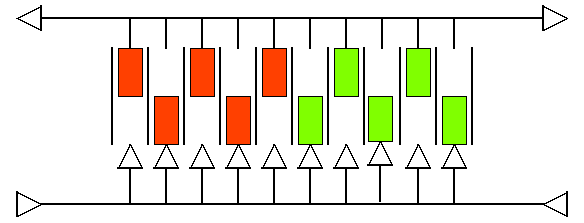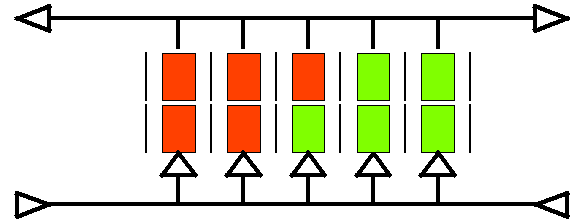|
If you have been involved in Solo for some time, you have likely had grid experiences both good and
bad from the worker and the participant side of things. A poorly run grid is painful for all parties
involved. However, you will likely not even notice a well run grid. Therefore, our goal is to make
grid so pleasant that no one notices it.
The Rules
Many of the "rules" of grid are de facto. However, there are a few actual rules in the National
Solo Rules book. The few that apply to grid operations are in sections 6.8 (Order of Running),
7.4 (Reruns).
First, a note about the "5 minute rule". There is only one place in the rules where a 5 minute
delay must occur. In section 7.4 it states: “A minimum of five minutes must have elapsed,
before a competitor may take a rerun.” At SCCA nationals, the timer runs from the time a
competitor arrives in grid until he has left the start line. Supplemental rules in your region may
state it differently, but the rule of thumb is to follow the nationals method. When the car arrives
in grid until it leaves the start line can be no less than 5 minutes. This should apply to reruns,
second drivers etc. There should be no case where a vehicle runs twice within 5 minutes.
Grid Configuration
There are a few good practices to help arrange a smooth running grid. First, ensure that the cars
are able to pull in and pull out of grid in a forward motion. We do not want cars backing up in
grid. Second, give the cars some space. Four feet of space between cars is really the minimum
practical spacing. Here are 3 of the basic grid layout designs. Naturally, choose the
configuration that fits the site.
Illustration 1: Side by Side with 12 foot spaces

Illustration 2: Alternating with 9 foot spaces

Illustration 3: Stacked with 12 foot spaces

Notice how cars will be able to pull in to their space from one side while others are progressing
to the start line. Avoiding any interference between these flows of traffic will reduce confusion.
Normal Grid Operations
So, how can you run a better grid? First, we must start with one basic piece of data. How long the
starter waiting between cars to launch? At fast events, this is around 20 seconds, at others, it
may be 30 seconds. If you are unable to discover this information prior to beginning your work in
grid, we must assume 20 seconds. This equates to 3 cars per minute or 15 cars for 5 minutes. This
information will be useful when determining spacing between second driver cars and reruns.
Second, review your list. If your venue does not provide a clipboard and list, review the cars in
grid. Two driver cars will likely be at the front of grid. If they are not, you will want them to
be. Ask the drivers if they are two driver or not in the event that someone has not shown up. As
you go talk momentarily to each of the two driver cars, let them know about how the 5 minute rule
will work for their heat. Also, let them know that they have 2 minutes to prepare.
Next, count down 15-16 cars and visit the "dividing" car (Car 16, point A). Inform the driver that
he will be held until the second driver cars have been released. This way, he will be able to
determine his wait times. Note this car's number and class.
Illustration 4: Cars in grid

As grid captain, you will have some helpers. One of your helpers will need to be informed of your
choice of "dividing" car. We will call this person "Helper 1".
Let's review our scenario. We have 22 cars in grid. Five of them are two driver cars and the
dividing line is between car 15 and 16. That means that we have 27 drivers in grid.
Illustration 5: Drivers in grid

We are now ready to start sending cars to the start line. The captain sends car 1 – 5 to the
line and then hands over the progression to Helper 1. Helper 1 will continue sending cars until they
get to point A. As Helper 1 begins down the line, you will need to "time" car number 1 from the time
that they arrive in grid until Helper 1 has arrived at point A. Also, when car number 1 arrives back
in grid, the captain should inform them that they will be called in approximately 3 minutes.
In the scenario being depicted here, there will be approximately 6 cars queued (9-15) at the start
line and there will be 2 minutes left on your timer. Second drivers will now follow car 15. Again,
time car 1 driver 2 from the time they arrive in grid. We need to ensure that we will not send the
car off at the start line again before 5 minutes is complete.
Once all of the second drivers have been sent, the captain hands control over to Helper 1 again.
Helper 1 will continue releasing cars from car 16 to the end of grid.
Now, you will notice in our example, that if everything is going according to plan, we will be ready
to send car number 1 before our timer has reached 5 minutes. This is where the grid captain would
either hold car 1 in grid or at the start line. As grid captain, it is your responsibility to adhere
to the "5 minute" rule. At larger events, walking them to the start line is preferred.
When you have sent the final car to the start line, inform timing of the end of the heat. This is as
simple as it gets. Now, let's discuss the exceptions.
Re-runs
Re-runs are generally regarded as a curse to grid. However, while it may seem a bit confusing,
re-runs do not have to be too problematic. First, re-runs need to occur ASAP. This means that any
re-run vehicle must be put on a 5 minute timer. The moment that 5 minutes is expired, the car should
be leaving the start line. Second, if a two driver car needs a re-run, the re-run must occur before
the alternate driver takes a run.
Many times reruns will involve multiple cars. Put a clock only on the first one. When the timer
expires, send all of the re-runs at once. The people in the timing truck will be in 're-run' mode
and be able to handle them all at once. They will bless you.
We must time re-runs for when they can be released for their re-run as well as timed again when they
return from their re-run to ensure that we do not try to release them too soon during the normal
rotation. If your venue happens to bless you with three grid workers, use the third person
(Helper 2) to track all re-runs and perform all timing for them.
In the event that you have too many re-runs to track properly (timer problems and such), don't be
afraid to stop the remainder of grid while re-runs are handled.
Mechanical Time-out
Competitors are allowed to call a "mechanical" during the course of a run (Section 6.8 D).
However, the request must be made by the competitor to the Chief Steward who will in turn notify the
grid captain of an official Mechanical Time-out. They are only allowed 1 mechanical per run and it
is 10 minutes from the time that the vehicle is scheduled to be on the start line until the time
when it must be. If the competitor is not prepared, the run is forfeited.
Refinements
If your timer says that a re-run has 1 minute remaining and there are 4 cars waiting at the start
line, send the re-run. Remember, the time is counted to the start line. The queue will still take
time to process. Use this to your advantage.
Competitors are feeling some stress. We can help ease some of that by giving warnings "down the line"
reminding them how long it will be before they are sent. Yell it out! “Two Minutes!”
Don't stack the start line. Too many cars in queue means that competitors may not be receiving
sufficient time in grid to cool tires etc. The queue should be 3 – 5 cars long.
Important Points
- Handle re-runs ASAP.
- Send two driver cars in numerical order (eg 20 first, 120 second).
- Mechanical time-outs are 10 minutes.
- Keep between 3 and 5 cars in queue at the start line.
- There are people in your grid too. It is up to you to ensure that people are driving safely in
grid for the purpose of avoiding accidents.
- Help the drivers. If you notice an oil spill under a car, inform the driver. Remind drivers to
put on their helmets when they have forgotten.
- Help drivers to avoid objects in grid.
- Communicate with your drivers. They like to know how much time they have.
Following these guidelines will help make grid exactly what it needs to be; smooth, efficient,
punctual and fair. Everyone will benefit from your knowledge on this topic. Let's make grid so
pleasant that no one notices it
Written by Park Wiker
Contributions by Michael Snyder
|


